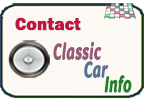Not everyone gets to own a Fifties and Sixties UK or European classic. Estimates are that of the twenty or so million vehicles produced during these years, only a few hundred thousand remain.
 After decades of use, or being stored, these bygones of a better age would never have survived in their original condition. The vast majority have undergone under some form of restoration, going on to become the pride and joy of their owners. And rightfully so, because these proud owners may well have spent considerable sums of money and time to bring them back to pristine condition.
After decades of use, or being stored, these bygones of a better age would never have survived in their original condition. The vast majority have undergone under some form of restoration, going on to become the pride and joy of their owners. And rightfully so, because these proud owners may well have spent considerable sums of money and time to bring them back to pristine condition.
Some of these restored classics have been brought back to their formal glary. These are genune collector's items. rarely, if ever driven, instead kept on display in museums or other forms of air- conditioned luxury as part of the private collection of wealthy owners.
For the average collector, their cars may well have been stored out of site and largely forgotten for decades in lock-up garages, in the corner of a field under a tarpaulin or simply left to fend for themselves against the rigours of UK and European weather conditions, before being restored.
 Now as they enter chapter two of their lives, these classic cars are driven only on weekends or special occasions, proudly displayed at car shows or owner's meetings.
Now as they enter chapter two of their lives, these classic cars are driven only on weekends or special occasions, proudly displayed at car shows or owner's meetings.
A surprisingly low percentage of restored vehicles are used as “daily drivers". The reason why is that to be maintained in good enough condition to face the demands of modern motoring.
The goal of ![]() is to provide those new to classic car restoration with an informative guide to help them plan their project, understand the stages involved, realise their limitations so they can avoid any pitfalls along the way.
is to provide those new to classic car restoration with an informative guide to help them plan their project, understand the stages involved, realise their limitations so they can avoid any pitfalls along the way.
Maintaining a restored class requires a lot of knowledge, to ensure that the recommended paths required to keep a classic car well maintained are being observed. In addition, advice on some of the skills and procedures required to implement some of the simpler jobs in-house.
The major maintenance procedures that should be followed by UK and European Classic Car include: ![]() : including the engine, ,gearbox, clutch, camshaft, carburettor, cooling system, cylinder head, driveshaft and exhaust system.
: including the engine, ,gearbox, clutch, camshaft, carburettor, cooling system, cylinder head, driveshaft and exhaust system.
![]() including convertible tops, chrome trim, metal trim, rubber seals, number plates, emblems, rear and side windows, windscreens, wire wheels.
including convertible tops, chrome trim, metal trim, rubber seals, number plates, emblems, rear and side windows, windscreens, wire wheels.

![]() including dashboards, gauges, sterring wheels wooden trim, plastic trim.
including dashboards, gauges, sterring wheels wooden trim, plastic trim.
![]() including
including
![]() including
including
For the countless thousands that have completed a classic car restoration, for the many more that are currently working on one and especially for those considering restoring a classic in the future, ![]() will continue to provide history, tips, tricks, terminology and news on all aspects of the wonderful world of classic cars.
will continue to provide history, tips, tricks, terminology and news on all aspects of the wonderful world of classic cars.
A guide to acquiring, restoring and maintaining UK or European Classic Cars of the Fifties and Sixties- as well as a recollection of the iconic cars of the era and the visionaries that produced them.
Got a question, a comment, a suggestion or an offer??? - FEEL FREE TO CONTACT US ANYTIME!!


